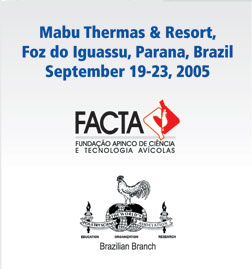Contributed Papers: Oral Presentations
Pathology |
The Stealth
Chicken Eimeria: E. mivati - a new perspective
Steve
H. Fitz-Coy
Schering-Plough Animal Health, Union, NJ 07083
steve.fitzcoy@spcorp.com
Summary: For several decades,
the validity of Eimeria mivati had been challenged
and some researchers have accepted this species to
be invalid. Over the past decade or more, several
field isolates that morphologically fit the description
of E. mivati, have been secured. Three of the recent
field isolates were purified and aliquots prepared
for evaluations via PCR assays to determine speciation.
Thirteen samples of Eimeria including three E. mivati
were submitted blindly to an independent laboratory
for PCR evaluations. The current primers are for E.
acervulina, E. brunetti, E. maxima, E. mitis, E. necatrix,
E. praecox and E. tenella. The results showed, the
samples detected were E. acervulina, E. maxima and
E. tenella, but the samples with E. mivati were undetected.
Chickens not protected against E. mivati by either
pharmaceuticals or immunization may suffer morbidity
and even mortality.
During 1988 and 1990, Fitz-Coy (University of Maryland
Eastern Shore), secured three isolates thought to
be E. mivati from commercial broiler farms on the
DelMarVa Peninsula (DMV). Immunization and cross-immunization
trials with one of the isolates against E. acervulina
showed that chickens immunized with E. acervulina
and challenged with E. mivati were not protected.
However, chickens immunized with E. mivati and challenged
with E. mivati showed good protection. Between 1991
and 2001, Fitz-Coy isolated several field isolates
of Eimeria fitting the description of E. mivati. These
isolates were from broiler farms from the state of
Georgia and the DMV, three of these were selected.
The selected isolates were further studied, including
species determined via polymerase chain reaction (PCR)
assay. In 2004, 13 samples of coccidia, identified
only by a numbering system were submitted to an independent
laboratory for PCR assays. Most of the samples were
single species, but a few were multiple species. The
identities of the samples were unknown and blindly
evaluated. Following evaluations, the results were
compared to the key to match the results with codes.
The only samples that were unidentified via the PCR
assay were E. mivati.
E. mivati is moderately pathogenic for chickens and
on some occasions, has caused mortality. In one such
study, a mortality rate of 40% occurred in a group
of naïve chickens; however, there was no pathology
in the hyper-immunized hatch-mates.
